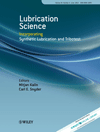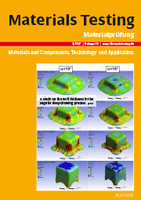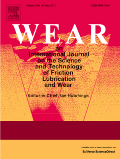
Journal of Friction and Wear
Scope & Guideline
Unraveling the Secrets of Material Performance
Introduction
Aims and Scopes
- Tribological Testing and Analysis:
The journal emphasizes experimental methodologies for assessing friction and wear characteristics of materials under various conditions, including mechanical, thermal, and chemical environments. - Materials Science and Engineering:
Research contributions often explore the development and modification of materials, such as coatings and composites, to enhance their tribological properties. - Computational Modeling and Simulation:
The use of computational techniques to predict friction and wear behaviors, including finite element analysis and molecular modeling, is a significant focus, reflecting the integration of theoretical frameworks with practical applications. - Surface Engineering and Coatings:
The journal covers advancements in surface engineering techniques, including the application of coatings and treatments to improve wear resistance and reduce friction. - Sustainability in Tribology:
Increasing attention is given to sustainable practices in tribological applications, such as the use of eco-friendly lubricants and materials, aligning with global trends towards environmental responsibility.
Trending and Emerging
- Nanotechnology in Tribology:
The integration of nanomaterials and nanostructured coatings is a rapidly growing area, focusing on enhancing tribological performance through improved surface properties and interactions at the nanoscale. - Advanced Composite Materials:
There is a noticeable trend towards the study of composite materials, particularly those incorporating polymers and additives, which aim to enhance wear resistance and reduce friction under various operational conditions. - Smart and Adaptive Materials:
Research into smart materials that can dynamically adjust their properties in response to environmental conditions is gaining traction, indicating a shift towards more responsive tribological systems. - Environmental and Biodegradable Lubricants:
The development and assessment of biodegradable and environmentally friendly lubricants are increasingly significant, reflecting a broader commitment to sustainability in material science and engineering. - Multiscale Modeling Approaches:
Emerging trends show a growing interest in multiscale modeling techniques that combine molecular dynamics with continuum mechanics to better predict tribological behavior across different scales.
Declining or Waning
- Traditional Lubrication Methods:
Research focused on conventional lubrication methods has decreased as newer, more innovative lubrication technologies and materials are explored, including environmentally friendly and bio-based lubricants. - Basic Wear Mechanisms:
Studies that only cover fundamental wear mechanisms without integrating advanced materials or coatings have become less prominent, as the field increasingly seeks to address complex interactions in tribological systems. - Friction in Non-Engineering Applications:
There appears to be a declining interest in applications of friction and wear phenomena in non-engineering contexts, such as basic physics or theoretical studies, in favor of more applied engineering research.
Similar Journals

Obrabotka Metallov-Metal Working and Material Science
Charting New Frontiers in Material Science ResearchObrabotka Metallov-Metal Working and Material Science is a pivotal journal published by Novosibirsk State Technical University, focusing on the dynamic fields of mechanical engineering, mechanics of materials, and the science of metals and alloys. With ISSN 1994-6309 and E-ISSN 2541-819X, the journal serves as a crucial platform for disseminating research from Russia and around the globe. Currently classified in the Q4 category for Mechanical Engineering and Mechanics of Materials, as well as Q3 for Metals and Alloys, it encompasses a wide range of studies from fundamental research to innovative applications. Despite its relatively recent inception in 2019, the journal has established itself with Scopus rankings that highlight its growing influence—Rank #122 out of 176 in Materials Science and Rank #510 out of 672 in Engineering. This journal aims to foster collaboration among researchers, professionals, and students by featuring original articles, reviews, and technical notes that address contemporary challenges in metal processing and material science. As it continues to evolve through 2024, Obrabotka Metallov remains dedicated to enhancing the understanding and application of materials science, making it a significant resource for those invested in the future of engineering and technology.

Tribology Online
Connecting global experts in the science of surfaces.Tribology Online, published by the Japan Society of Tribologists, is a dynamic open-access journal dedicated to the domain of tribology, encompassing research on surfaces, coatings, and films. Launched in 2013, this journal serves as a crucial platform for disseminating innovative findings in the field, highlighting its commitment to advancing knowledge and practice in tribological science. With an impact factor that places it in the Q3 quartile for the category of Surfaces, Coatings and Films, Tribology Online ranks 93rd out of 132 journals in its field, reflecting a growing engagement from the academic community. Open access since 2017, the journal promotes wide accessibility to research trends and technological advancements, making it an essential resource for researchers, professionals, and students pursuing cutting-edge developments in material sciences. Based in Tokyo, Japan, it aims to connect global experts and contribute to the evolution of tribological knowledge.

Friction
Advancing Knowledge in Mechanical Engineering and BeyondFriction is a renowned peer-reviewed open-access journal published by TSINGHUA UNIVERSITY PRESS, dedicated to the intricate field of Mechanical Engineering and the specialized areas of Surfaces, Coatings, and Films. Since its inception in 2013, the journal has rapidly ascended to prominence, achieving Q1 rankings in both categories as of 2023, thereby securing its place as a leading resource for researchers and professionals alike. With its impressive Scopus rankings—26th out of 672 in Mechanical Engineering and 10th out of 132 in Materials Science—the journal exemplifies outstanding academic rigor and contribution to its field. As part of its commitment to accessibility, Friction offers open access to all published articles, ensuring that groundbreaking research is freely available to scholars and practitioners worldwide. By bridging theoretical insights with practical applications, the journal aims to foster innovation and collaboration within the engineering community and beyond.

Materials Physics and Mechanics
Unlocking the Secrets of Material BehaviorMaterials Physics and Mechanics is a pivotal journal dedicated to advancing the fields of condensed matter physics, materials science, mechanical engineering, and the mechanics of materials. Published by the Institute of Problems in Mechanical Engineering, Russian Academy of Sciences, this journal has established itself as a valuable resource since its inception, particularly from 2003 to 2004 and now continuously from 2009 to 2024. Although it currently holds a Q4 categorization in various disciplines, its contributions are critical to understanding and developing new materials and their applications in engineering. The journal provides insightful articles that explore the nuances of material properties, their behaviors under different conditions, and the physical principles governing these phenomena. Though it operates under a traditional publication model, the insights provided within its pages are invaluable to researchers, professionals, and students striving to push the boundaries of knowledge in the materials domain. Its ISSN numbers (1605-2730, E-ISSN 1605-8119) serve as a gateway to a wealth of scientific knowledge emanating from the Russian Federation, contributing to the global discourse in materials physics and mechanics.

Advances in Tribology
Empowering the Future of Mechanical EngineeringAdvances in Tribology is a premier open access journal published by HINDAWI LTD, focused on the rapidly evolving fields of tribology, mechanical engineering, and materials science. Since its inception in 2008, the journal has provided a crucial platform for researchers, professionals, and students to disseminate knowledge and advancements in the understanding of friction, wear, and lubrication phenomena. With an impact factor reflective of its significance, Advances in Tribology is ranked in the Q3 category for both Mechanical Engineering and Surfaces, Coatings, and Films as of 2023, situating it among the prominent journals in its field. The journal's commitment to high-quality research is evident in its rigorous peer-review process and its dedication to fostering open access, allowing for widespread dissemination of impactful research. Published in Egypt with global reach, this journal aims to bridge the knowledge gap in tribological applications and innovations, serving as a key resource for those engaged in the study and application of surface interactions.

Lubrication Science
Bridging knowledge gaps in lubrication technology.Lubrication Science is a premier journal dedicated to advancing the field of tribology, focusing on the study and application of lubricants, lubrication methods, and their impacts in materials science. Published by WILEY, this journal serves as a critical platform for researchers and industry professionals alike, providing innovative insights and findings since its inception in 1988. With an ISSN of 0954-0075 and E-ISSN 1557-6833, the journal has established a commendable reputation in the academic community, holding a Q2 ranking in Materials Chemistry and a Q3 ranking in Surfaces, Coatings and Films as of 2023. Despite its recent emergence as a competitive publication, evidenced by its 47th percentile rankings in both subfields, Lubrication Science continuously seeks to bridge gaps in knowledge and foster collaboration among researchers. Its commitment to quality research is reflected in its detailed reviews and timely publication of original research articles. Although not an open-access journal, it remains an essential resource for anyone looking to keep abreast of the latest advancements and applications in lubrication technology, making significant contributions to sustainability and innovation in materials science.

Materials Testing
Exploring the Frontiers of Materials ScienceMaterials Testing is a renowned journal published by Walter de Gruyter GmbH, serving the global scientific community in the fields of Materials Science, Mechanical Engineering, and Mechanics of Materials. With an ISSN of 0025-5300 and an E-ISSN of 2195-8572, this journal has been a significant contributor to the discourse on material performance, testing methodologies, and engineering innovations since its inception. The journal is recognized for its rigorous peer-review process and holds a commendable Q2 quartile ranking in multiple categories for 2023, showcasing its impact and relevance in the field. With open access options available, Materials Testing aims to disseminate valuable research findings and practical insights that drive advancements in technology and materials applications. By addressing the latest challenges and developments within the field, this publication serves as an essential resource for researchers, professionals, and students alike, fostering a deeper understanding of material properties and testing techniques.

Lubricants
Connecting global researchers to revolutionize lubrication technology.Lubricants, published by MDPI, is a prestigious, peer-reviewed open-access journal that has been dedicated to advancing the field of lubrication technology since its launch in 2013. With its E-ISSN of 2075-4442, the journal is based in Switzerland and has rapidly established itself as a vital resource in the domains of Mechanical Engineering and Materials Science, achieving Q2 quartile rankings in both fields as of 2023. Lubricants provides a platform for the dissemination of innovative research, offering insights into the performance, formulation, and applications of lubricants across various industries. With a commitment to fostering collaboration and knowledge-sharing, this journal attracts a global audience of researchers, professionals, and students eager to explore the latest developments in lubrication technologies. Open access since its inception, Lubricants ensures that all published works are freely available, promoting greater visibility and accessibility of cutting-edge research in the field.

WEAR
Driving Insights into Condensed Matter PhysicsWEAR is a premier journal published by Elsevier Science SA, specializing in the field of materials science, particularly in the dynamics of wear and friction at the micro and nanoscale. Since its inception in 1957, this esteemed journal has evolved into a critical resource for researchers, professionals, and students alike, showcasing cutting-edge research and developments that significantly impact the disciplines of Condensed Matter Physics, Mechanics of Materials, Materials Chemistry, and Surfaces and Interfaces. With an impressive impact factor and consistently recognized as a Q1 category journal across various Scopus rankings, WEAR ranks in the top tiers of its field, underscoring its importance and influence within the academic community. The journal serves as a vital platform for disseminating innovative findings and applications, fostering scholarly dialogue, and advancing the understanding of material behaviors under wear and friction processes. For those keen on accessing the latest research in these dynamic areas, WEAR is an indispensable resource, promising a comprehensive collection of high-quality articles that reflect the forefront of scientific inquiry.

TRIBOLOGY LETTERS
Advancing Tribological Knowledge for Tomorrow's InnovationsTRIBOLOGY LETTERS is a distinguished peer-reviewed academic journal published by SPRINGER/PLENUM PUBLISHERS, focusing on advancements in the field of tribology and its applications across various engineering domains. With an ISSN of 1023-8883 and an E-ISSN of 1573-2711, this journal serves as a crucial platform for disseminating cutting-edge research and technological innovations, operating from its esteemed headquarters in the United States. The journal is categorized in the Q2 quartile across multiple domains including Mechanical Engineering, Mechanics of Materials, Surfaces and Interfaces, and Surfaces, Coatings and Films, showcasing its significant impact within the respective fields. With Scopus rankings placing it in the top 25% for Engineering and top 20% for Physics and Astronomy related categories, TRIBOLOGY LETTERS continues to be an essential resource for researchers, professionals, and students looking to deepen their understanding of tribological phenomena and enhance their applications in industry and technology. While it does not currently offer open access options, the journal continues to invite high-quality contributions that contribute to the ongoing dialogue and advancement in tribological science.